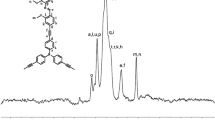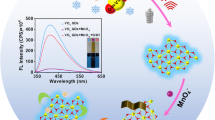Abstract
Photoinduced electron transfer (PET) has been used as reporter in the field of photoluminescence sensors and switches, and intermolecular PET is believed to be responsible for fluorescence quenching. Herein, the emissions of Tb-MOF can be quenched effectively by protamine based on PET. Compared with conventional electrostatic attraction mechanism, this approach suffers less interference from other charged substances and has a broader linear range of protamine from 3 to 5000 ng/mL with limit of detection (LOD) 1.21 ng/mL. Subsequently, the strong binding effect of protamine toward Hep ascribed to electrostatic attraction hinders the interaction between Tb-MOF and protamine, resulting in the high emissions of framework. The detection of Hep also shows a good linear range from 0.5 to 5 μM with LOD 0.27 μM. Finally, this novel probe is also successfully applied to the determination of protamine and Hep in human serum with satisfactory results.








Similar content being viewed by others
References
Wang C, Tang S, Lv X, Li L, Zhao X (2014) Zinc metal–organic frameworks based on a flexible benzylaminetetracarboxylic acid and bipyridine colinkers. Eur J Inorg Chem 19:3133–3139
Gándara F, Furukawa H, Lee S, Yaghi OM (2014) High methane storage capacity in aluminum metal–organic frameworks. J Am Chem Soc 136(14):5271–5274
Sadakiyo M, Yamada T, Kato K, Takata M, Kitagawa H (2016) A significant change in selective adsorption behaviour for ethanol by flexibility control through the type of central metals in a metal–organic framework. Chem Sci 7(2):1349–1356
Fei H, Cohen SM (2015) Metalation of a thiocatechol-functionalized Zr(IV)-based metal–organic framework for selective C–H functionalization. J Am Chem Soc 137(6):2191–2194
Acharyya K, Mukherjee PS (2014) A fluorescent organic cage for picric acid detection. Chem Commun 50(99):15788–15791
Zheng H, Zhang Y, Liu L, Wan W, Guo P, Nyström AM, Zou X (2016) One-pot synthesis of metal–organic frameworks with encapsulated target molecules and their applications for controlled drug delivery. J Am Chem Soc 138(3):962–968
Hu Z, Deibert BJ, Li J (2014) Luminescent metal–organic frameworks for chemical sensing and explosive detection. Chem Soc Rev 43(16):5815–5840
Cui Y, Yue Y, Qian G, Chen B (2011) Luminescent functional metal–organic frameworks. Chem Rev 112(2):1126–1162
Scattergood PA, Delor M, Sazanovich IV, Bouganov OV, Tikhomirov SA, Stasheuski AS, Meijer AJ (2014) Electron transfer dynamics and excited state branching in a charge-transfer platinum(II) donor–bridge–acceptor assembly. Dalton Trans 43(47):17677–17693
Zhang SR, Du DY, Qin JS et al (2014) A fluorescent sensor for highly selective detection of nitroaromatic explosives based on a 2D, extremely stable, metal–organic framework. Chem Eur J 20(13):3589–3594
Zhang F, Wang Y, Chu T, Wang Z, Li W, Yang Y (2016) A facile fabrication of electrodeposited luminescent MOF thin films for selective and recyclable sensing of nitroaromatic explosives. Analyst 141(14):4502–4510
Qin JH, Ma B, Liu XF, Lu HL, Dong XY, Zang SQ, Hou H (2015) Ionic liquid directed syntheses of water-stable Eu—and Tb–organic-frameworks for aqueous-phase detection of nitroaromatic explosives. Dalton Trans 44(33):14594–14603
Vasimalai N, John SA (2013) Aggregation and de-aggregation of gold nanoparticles induced by polyionic drugs: spectrofluorimetric determination of picogram amounts of protamine and heparin drugs in the presence of 1000-fold concentration of major interferences. J Mater Chem B 1(41):5620–5627
Jena BK, Raj CR (2008) Optical sensing of biomedically important polyionic drugs using nano-sized gold particles. Biosens Bioelectron 23(8):1285–1290
Wakefield TW, Hantler CB, Lindblad B, Whitehouse WM Jr, Stanley JC (1986) Protamine pretreatment attenuation of hemodynamic and hematologic effects of heparin–protamine interaction: a prospective randomized study in human beings undergoing aortic reconstructive surgery. J Vasc Surg 3(6):885–889
Meistrich ML, Mohapatra B, Shirley CR, Zhao M (2003) Roles of transition nuclear proteins in spermiogenesis. Chromosoma 111(8):483–488
Chu YQ, Cai LJ, Jiang DC, Jia D, Yan SY, Wang YQ (2010) Allergic shock and death associated with protamine administration in a diabetic patient. Clin Ther 32(10):1729–1732
Sorgi FL, Bhattacharya S, Huang L (1997) Protamine sulfate enhances lipid-mediated gene transfer. Gene Ther 4(9):961–968
Vidya R, Saji A (2018) Naked eye detection of infertility based on sperm protamine-induced aggregation of heparin gold nanoparticles. Anal Bioanal Chem 410(13):3053–3058
Ensafi AA, Kazemifard N, Rezaei B (2015) A simple and rapid label-free fluorimetric biosensor for protamine detection based on glutathione-capped CdTe quantum dots aggregation. Biosens Bioelectron 71:243–248
Long Q, Zhao J, Yin B, Li H, Zhang Y, Yao S (2015) A novel label-free upconversion fluorescence resonance energy transfer-nanosensor for ultrasensitive detection of protamine and heparin. Anal Biochem 477:28–34
Peng X, Long Q, Li H, Zhang Y, Yao S (2015) “Turn on-off” fluorescent sensor for protamine and heparin based on label-free silicon quantum dots coupled with gold nanoparticles. Sens Actuators B Chem 213:131–138
Zhao J, Yi Y, Mi N, Yin B, Wei M, Chen Q, Yao S (2013) Gold nanoparticle coupled with fluorophore for ultrasensitive detection of protamine and heparin. Talanta 116:951–957
Pang S, Liu S, Su X (2014) A fluorescence assay for the trace detection of protamine and heparin. RSC Adv 4(49):25857–25862
Song Z, Hong Y, Kwok RT, Lam JW, Liu B, Tang BZ (2014) A dual-mode fluorescence “turn-on” biosensor based on an aggregation-induced emission luminogen. J Mater Chem B 2(12):1717–1723
Chen XT, Xiang Y, Li N, Song PS, Tong AJ (2010) Fluorescence turn-on detection of protamine based on aggregation-induced emission enhancement characteristics of 4-(6′-carboxyl) hexyloxysalicylaldehyde azine. Analyst 135(5):1098–1105
Guan G, Sha J, Zhu D (2017) Heparin-MPA dual modified CdS quantum dots used as a simple and rapid label-free fluorescent sensor for protamine and hemin detection. Microchem J 133:391–397
Zhang Z, Miao Y, Zhang Q, Yan G (2015) Facile and sensitive detection of protamine by enhanced room-temperature phosphorescence of Mn-doped ZnS quantum dots. Anal Biochem 478:90–95
Tang B, Yang Y, Wang G, Yao Z, Zhang L, Wu HC (2015) A simple fluorescent probe based on a pyrene derivative for rapid detection of protamine and monitoring of trypsin activity. Org Biomol Chem 13(32):8708–8712
Yang ZR, Wang MM, Wang XS, Yin XB (2017) Boric-acid-functional lanthanide metal–organic frameworks for selective ratiometric fluorescence detection of fluoride ions. Anal Chem 89(3):1930–1936
Xiang L, Jingyan W, Qingyuan L, Jiang S, Zhang T, Shengfu JI (2014) Synthesis of rare earth metal–organic frameworks (Ln-MOFs) and their properties of adsorption desulfurization. J Rare Earths 32(2):189–194
Gao B, Fang L, Men J (2012) Studies on preparation, structure and fluorescence emission of polymer-rare earth complexes composed of aryl carboxylic acid-functionalized polystyrene and Tb(III) ion. Polymer 53(21):4709–4717
Meng F, Fang Z, Li Z, Xu W, Wang M, Liu Y, Guo X (2013) Porous Co3O4 materials prepared by solid-state thermolysis of a novel Co-MOF crystal and their superior energy storage performances for supercapacitors. J Mater Chem A 1(24):7235–7241
Li H, Shi W, Zhao K, Niu Z, Li H, Cheng P (2013) Highly selective sorption and luminescent sensing of small molecules demonstrated in a multifunctional lanthanide microporous metal-organic framework containing 1D honeycomb—type channels. Chem Eur J 19(10):3358–3365
Escudero D (2016) Revising intramolecular photoinduced electron transfer (pet) from first-principles. Acc Chem Res 49(9):1816–1824
Lu S, Wang S, Zhao J, Sun J, Yang X (2017) Fluorescence light-up biosensor for MicroRNA based on the distance-dependent Photoinduced electron transfer. Anal Chem 89(16):8429–8436
Zhang L, Zhu J, Guo S, Li T, Li J, Wang E (2013) Photoinduced electron transfer of DNA/Ag nanoclusters modulated by G-quadruplex/hemin complex for the construction of versatile biosensors. J Am Chem Soc 135(7):2403–2406
Liang Y, Wu Y, Feng D, Tsai ST, Son HJ, Li G, Yu L (2008) Development of new semiconducting polymers for high performance solar cells. J Am Chem Soc 131(1):56–57
Jo WJ, Nelson JT, Chang S, Bulović V, Gradečak S, Strano MS, Gleason KK (2016) Oxidative chemical vapor deposition of neutral hole transporting polymer for enhanced solar cell efficiency and lifetime. Adv Mater 28(30):6399–6404
Fan YZ, Zhang Y, Li N, Liu SG, Liu T, Li NB, Luo HQ (2017) A facile synthesis of water-soluble carbon dots as a label-free fluorescent probe for rapid, selective and sensitive detection of picric acid. Sens Actuators B Chem 240:949–955
Xia T, Zhu F, Jiang K, Cui Y, Yang Y, Qian G (2017) A luminescent ratiometric pH sensor based on a nanoscale and biocompatible Eu/Tb-mixed MOF. Dalton Trans 46(23):7549–7555
Rao H, Ge H, Wang X, Zhang Z, Liu X, Yang Y, Wang Y (2017) Colorimetric and fluorometric detection of protamine by using a dual-mode probe consisting of carbon quantum dots and gold nanoparticles. Microchim Acta 184(8):3017–3025
Capila I, Linhardt RJ (2002) Heparin–protein interactions. Angew Chem Int Ed 41(3):390–412
Whitelock JM, Iozzo RV (2005) Heparan sulfate: a complex polymer charged with biological activity. Chem Rev 105(7):2745–2764
Gunay NS, Linhardt RJ (1999) Heparinoids: structure, biological activities and therapeutic applications. Planta Med 65(4):301–306
García-Gutiérrez YS, Huerta-Aguilar CA, Thangarasu P, Vázquez-Ramos JM (2017) Ciprofloxacin as chemosensor for simultaneous recognition of Al3+ and Cu2+ by logic gates supported fluorescence: application to bio-imaging for living cells. Sens Actuators B Chem 248:447–459
Acknowledgements
This work was supported by the National Natural Science Foundation of China (Youth Fund Project) (21405093), the Scientific Research Foundation of Qufu Normal University (BSQD20130117), the Experimental Research Project of Qufu Normal University (jp201716) and Higher Educational Science and Technology Program of Shandong Province, China (Grant No. J15LC04).
Author information
Authors and Affiliations
Corresponding authors
Ethics declarations
Conflict of interest
The authors declare that they have no conflicts of interest to this work. We declare that we have no financial and personal relationship with other people or organizations that can inappropriately influence our work.
Electronic supplementary material
Below is the link to the electronic supplementary material.
Rights and permissions
About this article
Cite this article
Qu, F., Li, X., Lv, X. et al. Highly selective metal–organic framework-based sensor for protamine through photoinduced electron transfer. J Mater Sci 54, 3144–3155 (2019). https://doi.org/10.1007/s10853-018-3041-6
Received:
Accepted:
Published:
Issue Date:
DOI: https://doi.org/10.1007/s10853-018-3041-6




